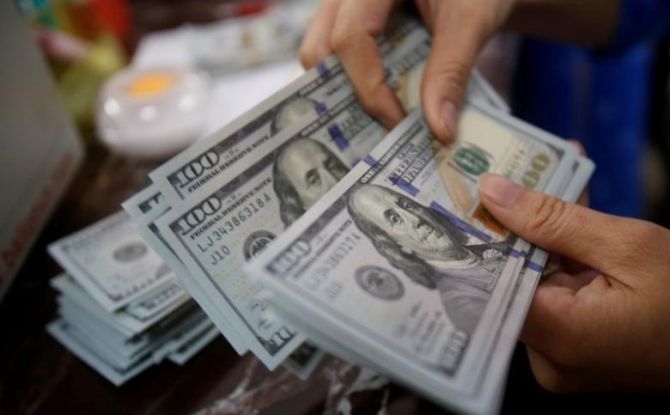 | « Back to article | Print this article |
What the reserves offer for now is improved import coverage of about 13 months, almost double the 2013 level of less than seven months. And, ammunition to arrest a rapid rupee slide, says Anup Roy.

India's foreign exchange reserves at over $400 billion look great. But the portfolio flow-driven accumulation comes with a set of uncertainties and challenges.
So, economists and currency dealers are not betting on great usage of this wealth.
What the reserves offer for now is improved import coverage of about 13 months, almost double the 2013 level of less than seven months. And, ammunition to arrest a rapid rupee slide if one is triggered, either by actions of the US Federal Reserve or geopolitical uncertainty.
However, even that would be limited and the Reserve Bank of India (RBI) will eventually have to let the rupee find its own level, experts say.
"Generally, reserves by itself do not mean much for the currency. It gives the comfort that the central bank has enough ammunition to intervene when flows reverse but will the RBI intervene in full force then is the question," says Jayesh Mehta, head of treasury at Bank of America-Merrill Lynch.
It is important to remember that the reserves have been accumulated due to the central bank's constant intervention in the market. So much so over the past year that currency dealers say the biggest buyer of the dollar in the market is the RBI, overshadowing the traditional big buyers, the oil marketing companies.
Year-to-date the central bank added a net $40 billion of reserves in its kitty.
In the same period, between January till now, total portfolio flow, in both debt and equities, was Rs 1,74,224 crore or roughly $27.2 billion.
Had the RBI not intervened in the market to buy dollars, the rupee would have reached 50-55 a dollar, wiping out India's export competitiveness.
According to Hitendra Dave, HSBC's head of global markets for India, dollar flows are unlikely to see a meaningful slowing in the near term and, therefore, the chance of rupee depreciation is less.
Besides, say currency dealers, if the central bank tries to actively depreciate the rupee, foreign investors would pour in more money, betting that they would be repatriating their investment at a time when the rupee would be stronger than their entry point.
That would be a never-ending cycle for the central bank, at a time when global liquidity is awash and places to invest the money are fewer.
Hence, it is unlikely that the reserves could be used to soften the exchange rate. At a time when India is attracting good investor interest, the reserves would continue to rise and the rupee to strengthen.
A strong rupee helps bring down imported inflation, as well as reducing the external debt. At at a time when the central bank is pursuing an inflation targeting framework, a relatively strong rupee is in the interest of the central bank.
Generally, every country tries to accumulate enough of forex reserves to maintain a certain number of months' import cover. However, that is also coming under more scrutiny.
The International Monetary Fund (IMF) maintains that the appropriate level of reserves cannot be determined without reference to the capital account. There is a weak relationship between reserves over imports and the occurrence or depth of crises, says IMF.
Still, it is generally considered useful to measure reserves against some monetary aggregate and/or some measure of external debt.
But, there are debates on whether three months of import cover is a good indicator or, say, eight months.
"There has been no study on the adequacy of forex reserves and import cover. We must also remember that it took about a decade for the RBI to increase its reserves by $100 billion," says Soumya Kanti Ghosh, group chief economist at State Bank of India.
He says he doesn't see much reason to be jubilant about accumulation of forex.
"No country in the world has managed to ward off a currency crisis based on the strength of their forex reserves," he added.
Rather, contrarily, accumulation of reserves has come to the RBI at a steep cost.
The central bank revealed in its report for 2016-17 that it earned a return of 0.8 per cent on its foreign currency assets, down from 1.29 per cent in 2015-16.
Apart from that, the RBI is incurring a huge cost to sterilise the liquidity brought on by intervention.
When the RBI buys dollars, it creates an equivalent amount of rupee liquidity in the market, which again has to be sterilised by issuing special bonds offering six per cent interest to investors.
The foreign funds are coming from countries that have near-zero per cent interest. Hence, the cost to the RBI is steep for building reserves through market intervention.
It actually doesn't make much of economic sense.
"How much of dollars can you buy? The whole world is running a carry trade; whoever buys the dollar is doing a reverse of the carry trade. It has a big cost," said Hitendra Dave.
Says Saugata Bhattacharya, chief economist of Axis Bank: "Sterilising the intervention-led liquidity is a very costly enterprise. It eventually pushes up interest rates in the economy and at the same time, since RBI invests in low-return foreign currency assets, the cost turns out to be much more than the return."